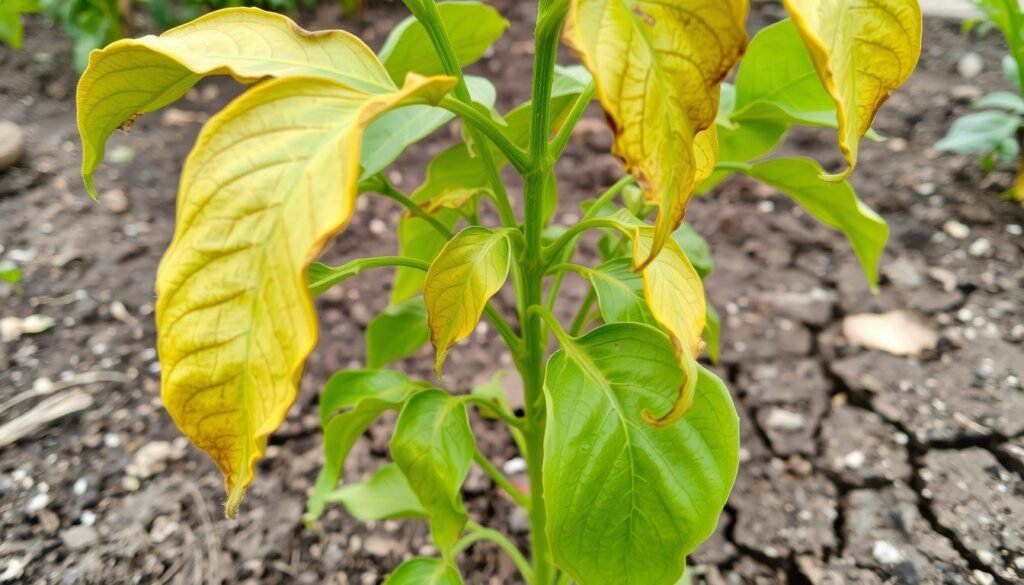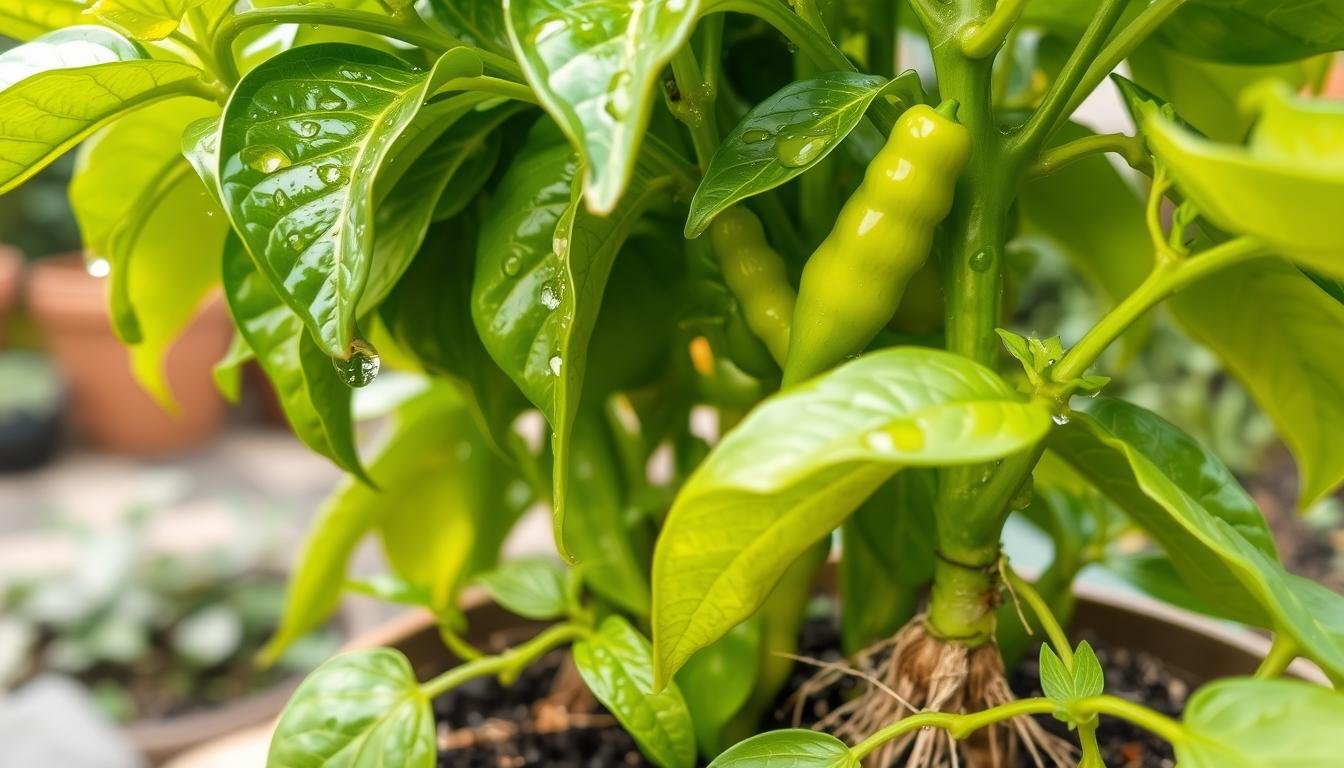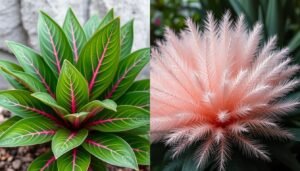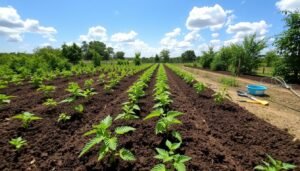Keeping my pepper plants watered correctly is essential, but can pepper plants be overwatered? Yes, they can, and it’s important to know the signs to prevent damage.
Overwatering shows up through yellow leaves and soft, wilting stems—early detection of these signs can save my garden. This guide will help you understand can pepper plants be overwatered and how to avoid it, keeping plants healthy and thriving.
Advice from resources like Reddit and plant care apps like PictureThis provides additional tips, ensuring that my pepper plants stay strong and continue growing well.
Key Takeaways
- Identify the signs of overwatering, including yellow leaves and mushy stems.
- Understand the specific water requirements of your pepper plants.
- Adopt preventive practices for healthy growth, shared by community experts.
- Adjust your watering habits seasonally to avoid wilting or root rot.
- Implement proper drainage methods for optimal soil moisture retention.
- Utilize plant care apps for expert advice on managing plant health.
- Seek professional guidance when faced with persistent symptoms of distress.
Table of Contents
Understanding Pepper Plant Water Needs
Caring for pepper plants means knowing their water needs. They do best in moist soil, which helps them grow and produce fruit. It’s important to find the right balance between too little and too much water.
Pepper plants don’t need a lot of water. Overwatering is a big problem. It can harm the plants.
Moisture Requirements
Pepper plants need the right amount of moisture. This depends on their size, the environment, and the soil. Young plants need more water than older ones.
Water them every 2-3 days when they’re growing. Signs of too much water can look like too little. Check the soil by sticking your finger in it. If it’s dry, it’s time to water.
Effects of Soil Type on Water Retention
The soil type affects how well pepper plants hold water. Loamy soils are best because they keep moisture better than sandy soils. Knowing this helps you water your plants right.
Larger pots hold water longer than smaller ones. Make sure your pots have holes to drain excess water. This prevents overwatering.
| Soil Type | Water Retention | Optimal Moisture Level |
|---|---|---|
| Loamy Soil | High | Evenly moist |
| Sandy Soil | Low | Requires more frequent watering |
| Clay Soil | Very High | Can lead to waterlogging |
By understanding these factors, you can help your pepper plants grow well. This way, they won’t get too much water.
Common Signs of Overwatering
It’s important to know the signs of overwatering in pepper plants. If not caught, it can harm the plants’ health. Let’s look at how it shows up.
Yellowing Leaves
Yellow leaves on pepper plants mean they’re getting too much water. Sometimes, these leaves also have brown spots. This shows the roots are struggling to get the nutrients they need.
Mushy Stems and Leaves
When stems and leaves feel mushy, it’s a bad sign. This happens when the plant is too wet. It weakens the plant and makes it more likely to get sick.
Musty Smell from Soil
A musty smell from the soil is a warning. It usually means root rot, caused by too much water. This can hurt the roots and even kill the plant.
Stunted Growth
Finally, overwatered plants grow slowly. They can’t grow well when they’re too wet. This means they won’t produce as much fruit.
Can Pepper Plants Be Overwatered?
Pepper plants need the right amount of water to grow well. They can get too much water, which is bad for them. Knowing how much water they need is key to their health.
Exploring Overwatering Risks
Peppers can get too much water, which hurts their health. Signs of too much water include:
- Wilting leaves
- Curling foliage
- Development of mold or root rot
- Stunted growth
- Fungus gnats appearing in the soil
Plants in pots dry out fast. They need good drainage to stay healthy. Watching them closely helps avoid problems.
Impact on Root Health
Too much water harms pepper plant roots. Roots need air to stay healthy. Without it, they can’t get nutrients well.
This makes the plants weak and more likely to get sick. It also changes the taste of hot peppers. Keeping the right moisture is key for good taste and growth.
To keep peppers healthy, watch how much you water them. Each type of pepper needs different care. Water them about an inch or two a week, depending on the soil and weather.
| Soil Type | Watering Frequency | Drainage Characteristics | Ideal for Peppers? |
|---|---|---|---|
| Sandy | Frequent (daily in hot weather) | Poor; dries out quickly | Yes, with mindful watering |
| Clay | Infrequent (every few days) | Hinders drainage | No, may lead to root problems |
| Silt | Moderate | Holds water well | Yes, with monitoring |
| Loamy | Ideal (weekly) | Balance of drainage and retention | Yes |
Identifying Underwatering vs. Overwatering

It’s key to know the difference between underwatering and overwatering for healthy pepper plants. Both can look similar, so I must check my plants’ needs closely. This way, I can give them the best care for strong growth and lots of fruit.
Signs of Underwatering
Here are the signs my pepper plants show when they’re not getting enough water:
- Drooping leaves that feel limp and lifeless.
- Crispy leaves that are dry to the touch, showing they need water.
- Dry soil that pulls away from the pot, making a gap.
- Stunted growth with new leaves or fruits that are smaller than expected.
How to Differentiate from Overwatering
It’s important to tell underwatering from overwatering by paying attention to details. Here’s how I make the distinction:
| Condition | Signs |
|---|---|
| Underwatering |
|
| Overwatering |
|
Spotting these signs helps me figure out if my plants need more or less water. Adjusting my watering based on these signs helps my pepper plants thrive.
Best Practices for Pepper Plant Watering
Creating a good watering schedule is key for healthy pepper plants. Using the right watering techniques helps keep roots moist without drowning them. Knowing when and how to water is crucial for your plants’ health.
Watering Schedule Recommendations
Pepper plants need about 1 to 2 inches of water each week. If they’re in containers, they might need more because of evaporation. My pepper plant watering schedule includes these tips:
- Water in the early morning to avoid disease.
- Use a meter or feel the soil to check moisture.
- Let the soil dry a bit before watering again.
- Water more often in hot weather or for container plants.
Deep vs. Shallow Watering Techniques
Deep watering is better for pepper plants. It helps roots grow deep to get nutrients and oxygen. Shallow watering can cause root rot. Here’s how I care for my pepper plants:
- Water deeply to moisten soil at least 6 inches deep.
- Use drip irrigation to avoid disease.
- Use mulch to keep moisture in and reduce evaporation.
Using these watering techniques helps avoid calcium problems from too much water. It also prevents issues like wilted or yellow leaves. For more tips on avoiding overwatering, check this resource.
| Condition | Watering Technique | Notes |
|---|---|---|
| Overwatering | Pause watering until soil dries | Look for signs like wilted or yellowing leaves |
| Underwatering | Deep watering | Ensure soil retains some moisture |
| Optimal moisture | Regular checks and adherence to schedule | Monitor weather changes for adjustments |
Improving Pepper Plant Drainage
Good drainage is key for healthy pepper plants. It stops overwatering, which can cause root rot or slow growth. The right pots and soil help a lot.
Choosing the Right Pot
For peppers, pick pots with drainage holes. These holes let water out, keeping soil just right. I like terracotta or unglazed ceramic pots. They let air to roots and control moisture.
- Drainage Holes: Make sure your pot has enough holes at the bottom.
- Material: Choose breathable materials like terracotta for better moisture control.
- Size: Pick pots big enough for roots to grow without being cramped.
Soil Amendments for Better Drainage
Soil amendments can make a big difference. Adding perlite, sand, or compost improves soil. A mix of 40% sand, 40% silt, 15% clay, and 5% organic material is perfect for peppers.
| Soil Composition | Percentage |
|---|---|
| Sand | 40% |
| Silt | 40% |
| Clay | 15% |
| Organic Material | 5% |
These amendments improve drainage and keep nutrients in. By choosing the right pot and soil, my pepper plants can grow well.
Preventing Overwatering in Pepper Plants
Keeping pepper plants healthy is key. It’s important to watch how much water they get. By using smart methods, I help my plants grow strong and green.
Monitoring Moisture Levels
I check the soil moisture often. A moisture meter gives me a clear reading. Or, I use a simple finger test.
When the soil feels dry, it’s time to water. This stops root rot and keeps my plants safe.
Weather Considerations
The weather changes how often I water. Hot weather means more water for my plants. But, cool or rainy days mean less.
By adjusting my watering based on the weather, my plants stay healthy all year. Good care helps prevent overwatering and keeps my plants strong.
Understanding Pepper Plant Potting Soil
Choosing the right potting soil is key for my pepper plants’ health and growth. The soil’s makeup affects how well they grow and how much water they keep. I must pick a mix that gives the right nutrients, drains well, and keeps moisture right.
Ideal Soil Composition
The best soil for peppers has organic matter like compost and peat moss, plus minerals like perlite or vermiculite. This mix helps water drain but also keeps it in the soil. A good potting mix for peppers might be:
- 40% compost or well-rotted manure
- 30% peat moss
- 20% perlite
- 10% vermiculite
How Potting Soil Affects Water Retention
Keeping water in the soil is vital for pepper plants. A light mix lets water drain but still holds onto it, which is key when it’s dry. Too much water can cause problems like root rot and wilted leaves. Finding the right balance in my soil will help my plants grow and produce more fruit.
| Component | Function |
|---|---|
| Compost | Adds nutrients and improves soil structure |
| Pearl | Enhances drainage and aeration |
| Peat Moss | Increases water retention in soil |
| Vermiculite | Improves moisture retention and nutrient availability |
Adjusting Your Watering Habits
To make sure my pepper plants do well, I need a steady water plan. This plan looks at how much water my plants need and what the weather is like. Checking the soil often helps me avoid too much or too little water. This way, I can adjust for my pepper plants’ needs at each stage of growth.
Establishing a Water-Management Routine
Creating a water plan means watching for changes in the weather. When it’s hot and dry, my peppers need more water. But when it’s cooler or after it rains, I can water them less. Knowing what my plants need in each season helps them grow strong and healthy.
Considerations for Different Seasons
As the seasons change, so do my plants’ needs. Temperature, humidity, and how big my plants are all matter. For example, young plants need more water than older ones. In the cold winter, they need even less.
By changing my watering plan with the seasons, I keep my plants happy and productive all year. This helps them stay healthy and grow well.




